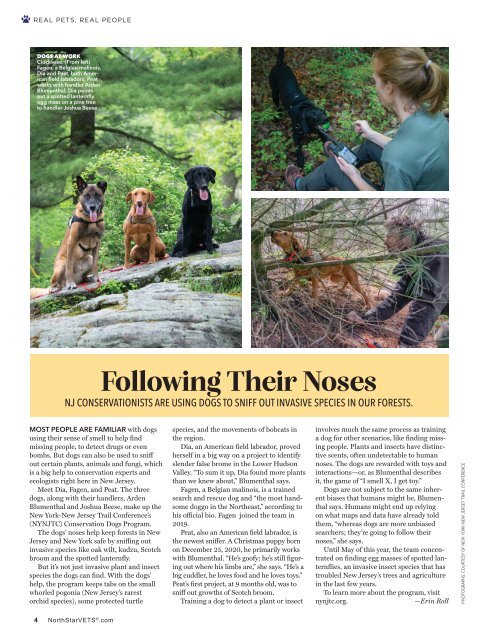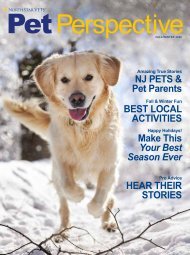2023_NorthStarVets_Pets_Digital_Issue
You also want an ePaper? Increase the reach of your titles
YUMPU automatically turns print PDFs into web optimized ePapers that Google loves.
REAL PETS, REAL PEOPLE<br />
DOGS AT WORK<br />
Clockwise: (From left)<br />
Fagen, a Belgian malinois,<br />
Dia and Peat, both American<br />
field labradors; Peat<br />
works with handler Arden<br />
Blumenthal; Dia points<br />
out a spotted lanternfly<br />
egg mass on a pine tree<br />
to handler Joshua Beese.<br />
Following Their Noses<br />
NJ CONSERVATIONISTS ARE USING DOGS TO SNIFF OUT INVASIVE SPECIES IN OUR FORESTS.<br />
MOST PEOPLE ARE FAMILIAR with dogs<br />
using their sense of smell to help find<br />
missing people, to detect drugs or even<br />
bombs. But dogs can also be used to sniff<br />
out certain plants, animals and fungi, which<br />
is a big help to conservation experts and<br />
ecologists right here in New Jersey.<br />
Meet Dia, Fagen, and Peat. The three<br />
dogs, along with their handlers, Arden<br />
Blumenthal and Joshua Beese, make up the<br />
New York-New Jersey Trail Conference’s<br />
(NYNJTC) Conservation Dogs Program.<br />
The dogs’ noses help keep forests in New<br />
Jersey and New York safe by sniffing out<br />
invasive species like oak wilt, kudzu, Scotch<br />
broom and the spotted lanternfly.<br />
But it’s not just invasive plant and insect<br />
species the dogs can find. With the dogs’<br />
help, the program keeps tabs on the small<br />
whorled pogonia (New Jersey’s rarest<br />
orchid species), some protected turtle<br />
species, and the movements of bobcats in<br />
the region.<br />
Dia, an American field labrador, proved<br />
herself in a big way on a project to identify<br />
slender false brome in the Lower Hudson<br />
Valley. “To sum it up, Dia found more plants<br />
than we knew about,” Blumenthal says.<br />
Fagen, a Belgian malinois, is a trained<br />
search and rescue dog and “the most handsome<br />
doggo in the Northeast,” according to<br />
his official bio. Fagen joined the team in<br />
2019.<br />
Peat, also an American field labrador, is<br />
the newest sniffer. A Christmas puppy born<br />
on December 25, 2020, he primarily works<br />
with Blumenthal. “He’s goofy; he’s still figuring<br />
out where his limbs are,” she says. “He’s a<br />
big cuddler, he loves food and he loves toys.”<br />
Peat’s first project, at 9 months old, was to<br />
sniff out growths of Scotch broom.<br />
Training a dog to detect a plant or insect<br />
involves much the same process as training<br />
a dog for other scenarios, like finding missing<br />
people. Plants and insects have distinctive<br />
scents, often undetectable to human<br />
noses. The dogs are rewarded with toys and<br />
interactions—or, as Blumenthal describes<br />
it, the game of “I smell X, I get toy.”<br />
Dogs are not subject to the same inherent<br />
biases that humans might be, Blumenthal<br />
says. Humans might end up relying<br />
on what maps and data have already told<br />
them, “whereas dogs are more unbiased<br />
searchers; they’re going to follow their<br />
noses,” she says.<br />
Until May of this year, the team concentrated<br />
on finding egg masses of spotted lanternflies,<br />
an invasive insect species that has<br />
troubled New Jersey’s trees and agriculture<br />
in the last few years.<br />
To learn more about the program, visit<br />
nynjtc.org. —Erin Roll<br />
PHOTOGRAPHS: COURTESY OF NEW YORK-NEW JERSEY TRAIL CONFERENCE<br />
4 NorthStarVETS ® .com
















